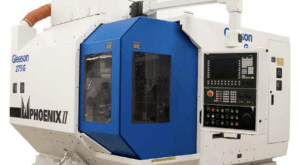“Drop-in” replacement actuator from Tolomatic improves coolant head positioning accuracy in gear-grinding machine
Problem:
Actuator overload caused by increased friction in system resulted in machine faults and reduced productivity
Solution:
Tolomatic RSA rod-style electric actuators with servo motor compatibility in a reverse-parallel configuration easily handles torque and system requirements.
Results:
Increased productivity and flexibility with no reports of machine faults.
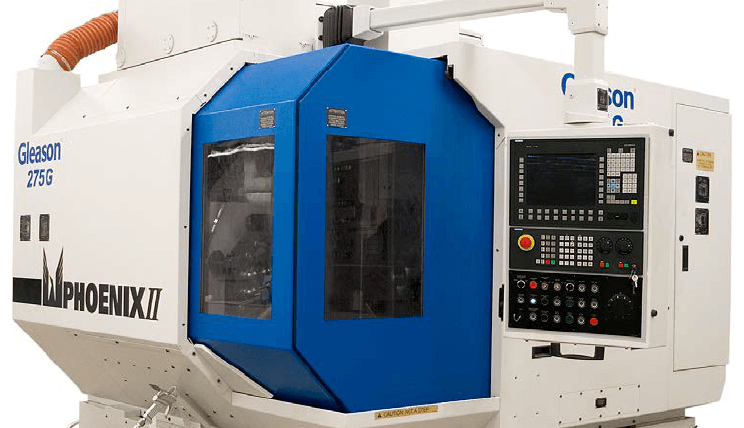
“Drop-in” replacement actuator from Tolomatic improvescoolant head positioning accuracy in gear-grinding machine
ROCHESTER, NY – As the company that pioneered the development of the bevel gear used in vehicle differentials, Gleason Corporation demands that its latest automated gear grinding machines be in the forefront of efficient and high-quality gear production. One key to quality is making sure that the work piece is well lubricated and does not become overheated during the grinding process. That’s why when Gleason needed a replacement actuator to position a heavy coolant head on its Phoenix® II 275G gear grinding machine, the company turned to Tolomatic, Inc. of Hamel, Minnesota for a solution.“The Phoenix II 275G gear grinding machine is designed to create a fine finish on the mating surfaces of bevel gears that have already been rough cut,” says George Chamberlain, a Gleason design engineer. “Once the mating surfaces are properly ground, the gears are interchangeable in gearing systems and run efficiently and quietly. Grinding is becoming the preferred bevel gear finishing method, as opposed to the traditional gear lapping process, in which mating gears are lapped together with an abrasive slurry to create a matched pair.”
Positional accuracy is critical
To insure that the gear grinding process produces the best finish on the gear surfaces, a flow of lubricating coolant needs to be precisely directed at the grinding wheel’s point of contact with the gear at all times. “Positional accuracy of the coolant heads is necessary because you have to flood the point of contact with coolant so you don’t burn the part,” says Chamberlain. “The coolant also provides lubrication and flushes away the grinding debris created from the process.”
In the original design of the machine, an electric actuator was responsible for moving a 50-pound manifold of coolant jets in small increments as the grinding wheel was consumed and changed dimensions. However, the original motor/actuator used in the machine sometimes lacked the necessary torque to move the heavy coolant manifold. It was found that when the actuator was overloaded due to increased friction in the system, it would stop and sometimes lose its position.
“This would cause the machine to send a message to the operator to investigate the situation before the start of the next cycle.” says Chamberlain. “The machine would indicate a positional error and then you would have to re-reference the position of the coolant.” Needless to say, this was non-productive time that reduced overall productivity for some of Gleason’s customers.
Solution is powerful and compact
One solution would have been to replace the original actuator’s stepper motor with a more powerful servo motor, but the actuator Gleason was using didn’t allow such a replacement. And, even if it had, there was insufficient space inside the machine’s grinding chamber to accommodate a motor that was physically larger or more powerful.
That’s when Chamberlain consulted with Brian Mulholland of Hughes Hi-Tech in Clarence, NY, a distributor for Tolomatic, Inc., and learned that Tolomatic actuators could accept a more powerful servo motor. In addition he found that the Tolomatic RSA rod-style screw actuator was not only powerful but extremely compact.
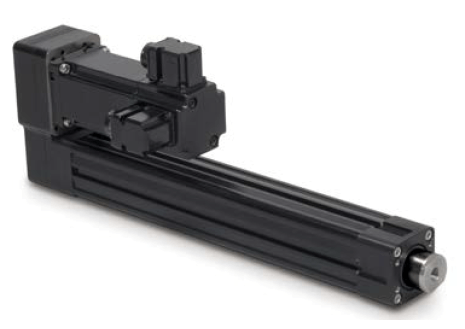
The Tolomatic RSA rod-style actuator series is designed for high performance, high thrust,
durability and compact mounting flexibility.
“The most important factors in choosing the Tolomatic brand actuator were its overall torque and its compact design,” says Chamberlain. Most rod-style actuators have a screw that is driven by a motor connected inline. Tolomatic’s RSA actuators feature a reverse-parallel motor drive where the motor is mounted along side the actuator and drives the screw through a toothed belt and pulley assembly. “Every other actuator we looked at had the motor bolted to the backside of the actuator, making the units too long to fit into our design window,” he says.
The Tolomatic RSA rod-style actuator series is designed for high performance, high thrust, durability and compact mounting flexibility. With thrust capability ranging from 70 pounds to 7,000 pounds, even the smallest 12-inch model had enough power for Gleason’s application. The product line also features black anodized extrusion designed for rigidity and strength, ball screw, roller screw or acme screw options and robust internal guide bearings to support the screw assembly throughout its entire stroke.
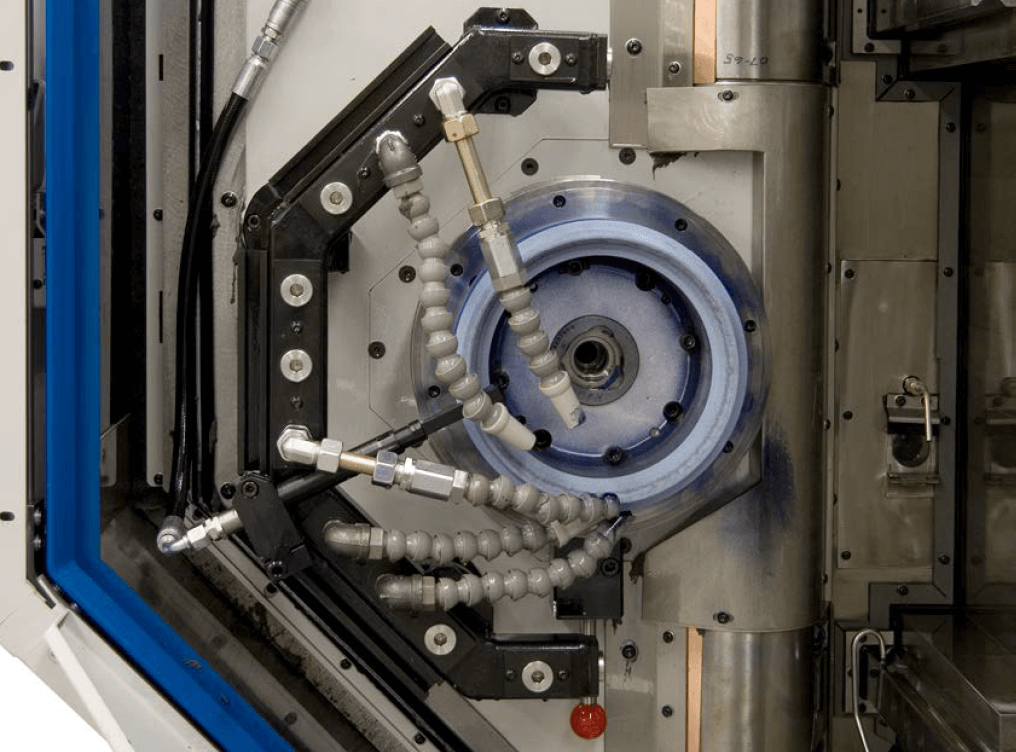
The heavy, C-shaped coolant manifold on the Phoenix II 275G gear grinding machine is moved incrementally by a Tolomatic RSA actuator as the circular grinding wheel wears away. This keeps the coolant flow precisely directed at the point of contact with the gear face.
Modifications to a standard product
While the RSA rod-style actuator is a standard product for Tolomatic, the company also has the in-house design capability to modify standard products to meet the special needs of its customer. In Gleason’s case, a number of modifications were made to the RSA actuator.
- Sealed actuator – The mating surfaces of the motor mount, drive belt housing and inspection lid had to be fully gasketed to prevent spraying coolant from getting into the actuator.
- Optional motor mounts – The actuator was supplied with two motor mounting flanges to accommodate different brands of servo motors. This gave Gleason the flexibility to match either a Fanuc or Moog servomotor to the production demands of its customers.
- Secondary lead screw bearing – The end of the actuator was fitted with a secondary support bearing to accommodate the high radial loads due to drive belt tensioning.
- Custom front flange – The end of the rod was fitted with a custom mounting flange to mate with Gleason’s coolant head assembly, allowing drop-in compatibility during manufacture or in the field.
- Additional sensor – In the unlikely event the drive belt broke, Gleason wanted the machine to have a feedback loop to avoid process issues associated with the coolant header being out of position. This was accomplished by installing a toothed rotor to the end of the screw and mounting a Balluff sensor. The sensor reports the position of the screw within 0.1 mm and signals the machine if a belt failure occurs.
Gleason manufactures a number of Phoenix® II 275G gear grinding machines each year, and since incorporating the Tolomatic RSA actuator into the design there have been no reports of coolant system or machine fault issues. “We also have a retrofit kit available for machines in the field with the old style actuators, but the Tolomatic actuator has pretty much eliminated all of our problems with the coolant heads,” says Chamberlain.
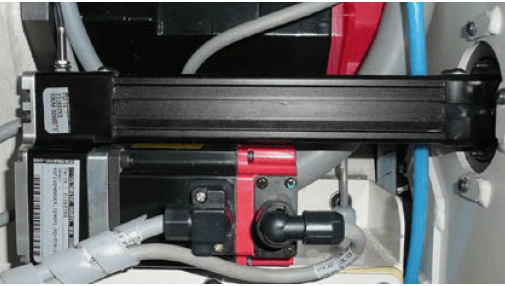
Tolomatic’s RSA actuator features a reverseparallel motor drive with the motor mounted
along side the actuator, driving the screw through a toothed belt and pulley assembly.
The compact actuator series is designed for high-performance thrust from 70 to 7,000
pounds, accuracy and durability.

 Ask an Engineer
Ask an Engineer